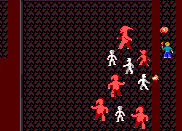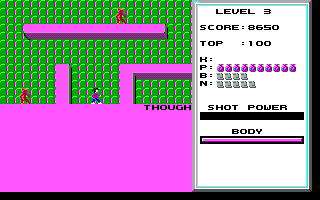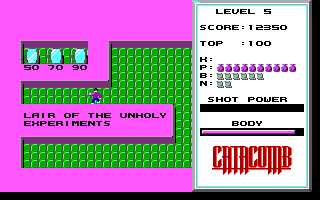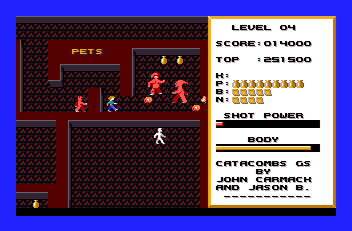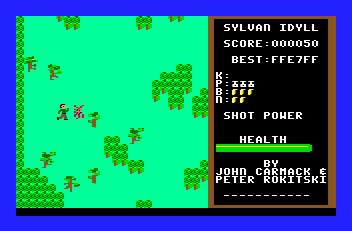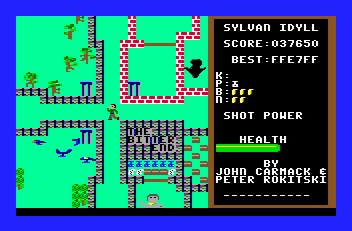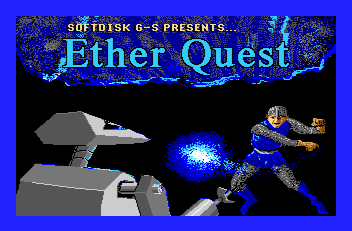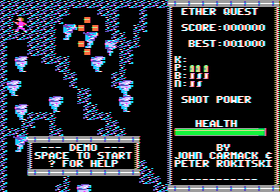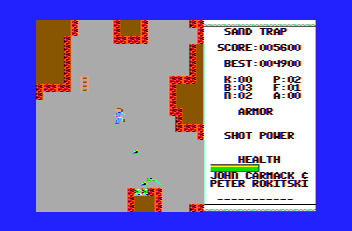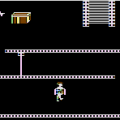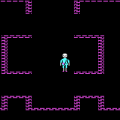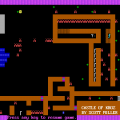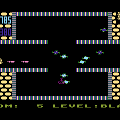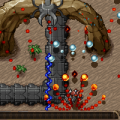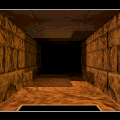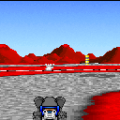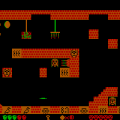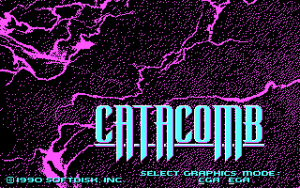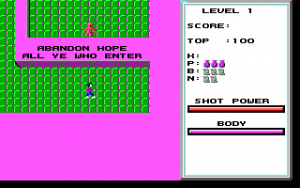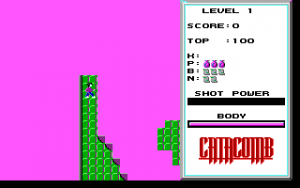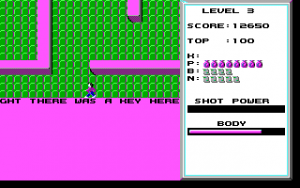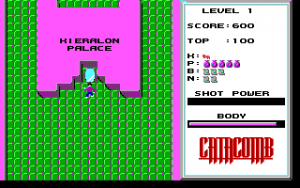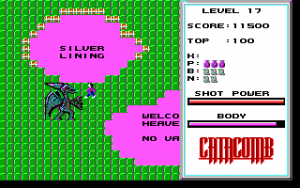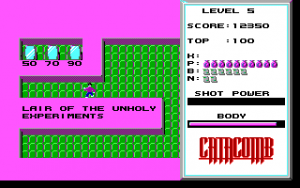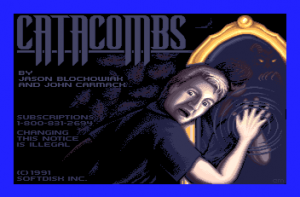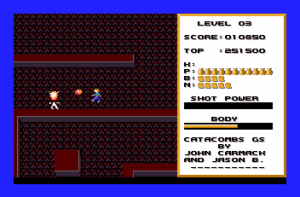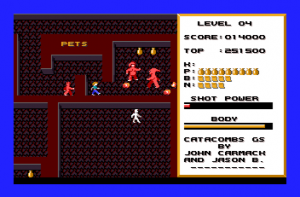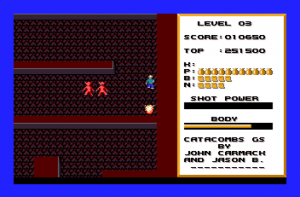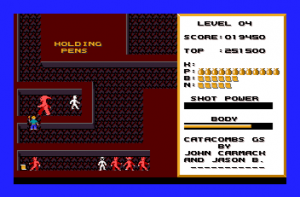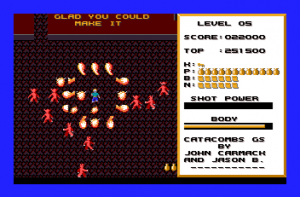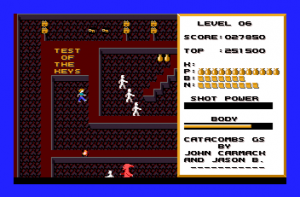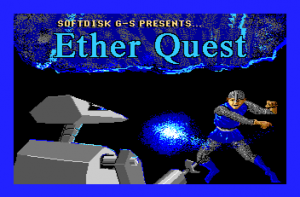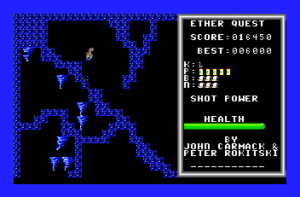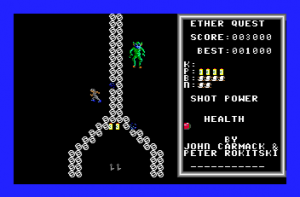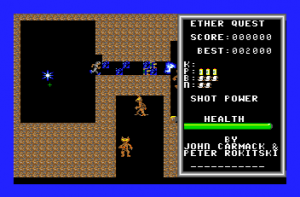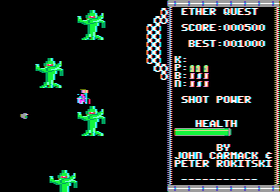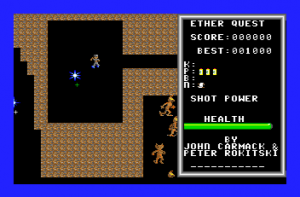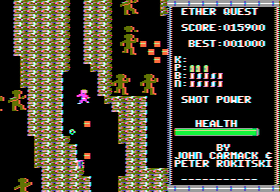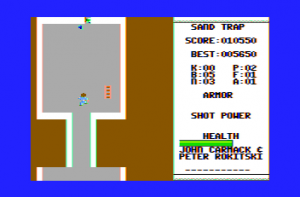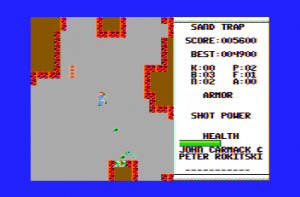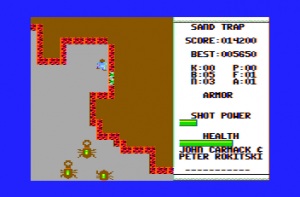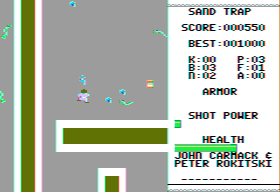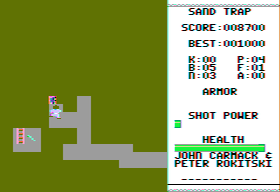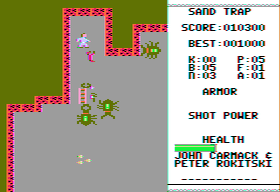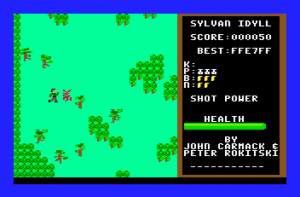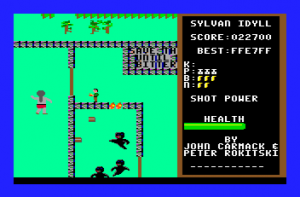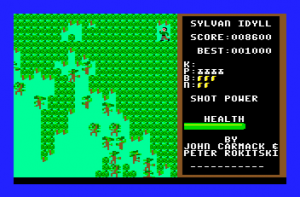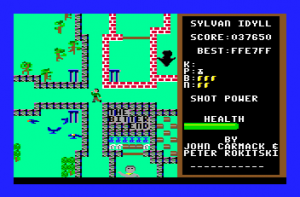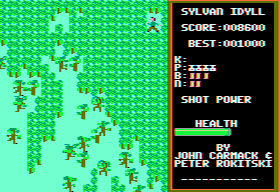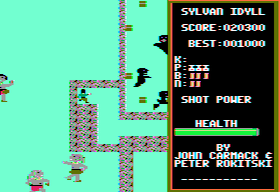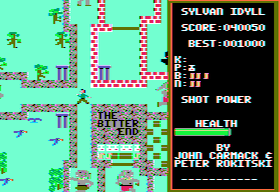- Catacombs
- Catacombs 3D
Part One: The 2-D Quadrilogy
In the year 1990, programmer John Carmack was working at the offices of Softdisk, a distributor of several “disk magazines” for various popular computer platforms at the time. He was working alongside fellow programmer John Romero, artist Adrian Carmack and editor Tom Hall. John Carmack submitted a game to be included with an issue of Big Blue Disk, Softdisk’s publication for IBM computers. Although Big Blue Disk had published games in the past, this top-down fast-paced arcade title was different. This game was called Catacomb.
In Catacomb, the player assumes the role of Petton Everhail, a powerful magician. Gameplay is similar to that of Gauntlet, in which the player moves from room to room, unlocking doors and shooting at several monsters at a time in an effort to find the exit which leads to the next level. The arsenal is Catacomb is a bit more varied, however, with four different types of weaponry that can be used. There is a regular shot, a powered up shot which is activated by holding down the shot button, and two “spells” which have a limited amount of uses. These are labeled Bolt and Nuke and can be found scattered among the dungeon floors. Bolt shoots a series of powered up shots in a straight line in front of the player automatically, while Nuke releases a single powered up shot in every direction from the player. Both can be useful in getting out of tight spots.
As a harbinger of things to come from Carmack, Petton has been given the ability to strafe. The player can activate “Strafe Mode” and move in any direction while firing in a different direction. As possibly the only Apple II game with the ability to strafe, it seems unnecessary. From a top-down view point, there aren’t going to be any monsters who will sneak around the corner or lay in wait for an ambush. But it’s a good addition to have.
Another hallmark of Catacomb is the one-liners and other remarks that are written on the dungeon walls. For one example, in level 5, the player is placed in a small empty square with the words THE END written directly above. Once the player finds out, however, that a hidden passageway reveals the path to the rest of the level, the words “GLAD YOU COULD MAKE IT” are written further down. These keep the tone of the game firmly tongue-in-cheek.
Speaking of secret passageways, Catacombs is filled with them. They look like ordinary walls, but disappear when shot at. Some are needed to be revealed in order to progress further in the game (such as in the first level), while others are simply to hide extra potions and scrolls. These passageways are (sometimes) marked by tiny pixel spots along the walls. Although they are not immediately noticeable, they are a good indicator of how to progress if the player finds themselves stuck in a level with no apparent exit.
Catacomb proved to be immensely popular, and was shortly ported thereafter to appear on Softdisk’s flagship self-titled publication for Apple II computers. There has been some confusion as to which version appeared first. It’s possible that the Apple II version was developed first, but in terms of release date, however, the DOS version appeared on the Big Blue Disk issue #50 of December 1990, while the Apple II version appeared on Softdisk issue #114 of March 1991. The Apple II version is almost exactly identical, except for a few small changes. There are 5 additional levels over the DOS version, for a total of 15. Unfortunately, due to the graphical limitations of the Apple II, there are no more “weak wall” indicators to be seen. This is especially frustrating if the player had never played the DOS version first. It grinds the action of the game to a halt as the player searches for every inch of wall that could be possibly shot at, looking for an opening.
Around this time, Softdisk was also running a sister publication titled Softdisk G-S which was developed specifically for the Apple IIGS line of computers. Naturally, Catacombs made an appearance here as well. It was ported to the IIGS by Jason Blochowiak (who would later join id Software as an additional programmer). Stylistically, it’s the best looking port, even if it doesn’t carry any improvements over the regular Apple II version.
In 1993, an expanded version of Catacombs was released titled The Catacomb. This version doubles the amount of levels to 30 and includes all-new levels from those used in the original title. Although the graphics were not changed, the game play also stayed intact from the original version and remains fast-paced.
Sylvan Idyll – Apple II, Apple IIgs (1992)
Roughly a year after the Apple II version of Catacombs was released, Softdisk put out a sequel titled Sylvan Idyll. Instead of being underground, Petton Everhail now fights monsters through a thick forest. Heading development of this sequel is Peter Rokitski, who would continue to develop the rest of the Softdisk Catacombs series. Despite Carmack continuing to be credited as co-developer, he is only included for the original design of the game engine and did not contribute to any of the Softdisk-released sequels (Rokitski would also go on to re-use Carmack’s Dark Designs engine to develop Vols. IV, V and VI of that series).
The sequel doesn’t differ much from the original as far as gameplay is concerned. The game is still 15 levels long and although the difficulty seems to have been increased from its predecessor, it doesn’t try anything new. The IIgs port was developed by Nate Trost & Linoleum Software. Trost would continue to have a successful programming career after Softdisk for a variety of consoles and computers. The Sylvan Idyll port has slightly updated graphics and feels more fluid, to a fault – sometimes the enemies move too fast in certain spots.
Ether Quest – Apple II, Apple IIgs (1993)
The next title in the Catacomb series finds Petton Everhail being transported onto the “ethereal plane” between time and space. Instead of following a linear progression of levels, the player now has the ability to transport back and forth between several different points in the game from the starting room. Although the core gameplay hasn’t changed, it provides a different enough twist from the previous games for it to remain fresh. The difficulty is the hardest of the initial series; most of the regular enemies in this game would have been considered to be bosses in the previous entries.
The IIgs port was once again developed by Trost (with Greg Templeman providing assistance), and like Sylvan Idyll, this version has slightly updated visuals and smoother gameplay, but doesn’t improve that much over the original.
Sand Trap – Apple II, Apple IIgs (1994)
The last title of the original Catacomb series is also the most ambitious. Petton Everhail is now transported into a pyramid and must find his way out. Although the level selection of Ether Quest has been removed for a more singular level progression method, there are still ladders that the player can use to go to the next level or go back from each level. The biggest addition is two new special powers that can be used along with potions, bolts and nukes. The first is an armor that adds a shield for extra protection and can be obtained once every 10,000 points scored. The second is the ability to freeze time and move around enemies without them being able to attack. Although neither one of the new abilities hamper the enjoyment of the game in any way, it does become a bit unwieldy for those using a joystick to reach out and hit five different buttons to perform different actions. Overall, the series does end on a high note for those who are still have an interest up to this point.
However, the IIgs port is a different story. There are no credits for those involved in bringing it to the IIgs – which is just as well, considering that virtually nothing has been changed. In fact, it would probably be better to call it a conversion instead of a port. It’s a disappointing harbinger of things to come from the IIgs department of Softdisk. The magazine would be shuttered less than a year later.
